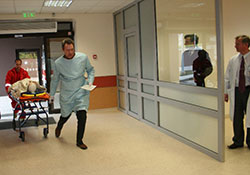World Health Day 2009 – Save lives. Make hospitals safe in emergencies

WHO
World Health Day 2009 focused on the safety of health facilities and the readiness of health workers who treat people affected by emergencies. Health centres and staff provide vital health care in communities every day. In disasters, their services are in even greater demand: treating injuries, preventing illnesses and caring for people’s urgent health needs.
A safe hospital that continues to function at optimum capacity during and after a disaster or other emergency is a safe haven that protects lives. Safe health facilities are a joint responsibility, requiring crucial support from other sectors to ensure essential life-lines. When health facilities stop functioning, it is a double blow to a devastated community.
Natural disasters in the WHO European Region are increasing in number and severity. In 1990–2008, over 47 million people in the Region were affected by floods, extreme temperatures, drought, wild fires, earthquakes, accidents, mass movements (avalanches, landslides, rockfalls and subsidence) and storms. The economic damage of these events exceeded US$ 246 billion.
Hospitals are often assumed to be ready to cope with emergencies, but investment and particular efforts are required to ensure they are constructed and managed so that they can continue to function in a crisis, when they are needed most to save lives. The cost of making a hospital safe need not be great. The low-cost, high-impact interventions available can reduce risks, and increase the resilience of new and existing facilities.
How a hospital performs in an emergency not only affects the immediate victims but also has long-term consequences for health care, as reconstruction takes both time and resources. Making hospitals and health facilities safe from disasters is an economic requirement and a social necessity.



